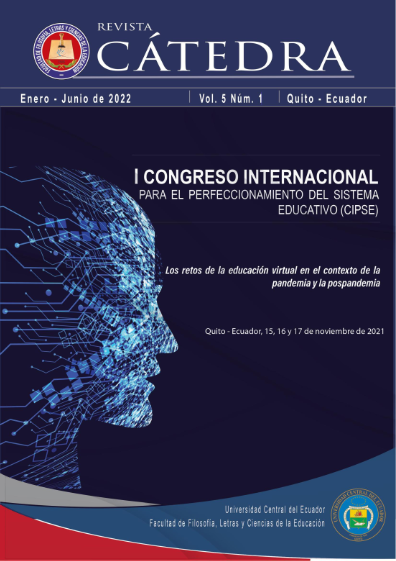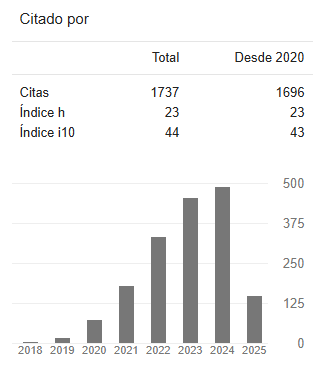Didactic, technological and communicational considerations for EVEA design
DOI:
https://doi.org/10.29166/catedra.v5i1.3447Keywords:
virtual teaching and learning environment, ADDIE, andragogy, Moodle, ICTAbstract
In this research we determined the didactic, pedagogical, technological aspects as well as the learning methodologies which should be considered in order to develop an VTLE that guarantees a quality learning. For this purpose, we used the qualitative approach supported by the design of the grounded theory with the purpose of generating theories, concepts or hypotheses from the analysis of the interviewees' points of view and the contrast with the literature previously analyzed. In this sense, we interviewed 8 experts in the subject of design and implementation of VTLE and the data obtained were analyzed by means of the software ATLAS.TI 8, following the model of the emergent conception.
According to the results obtained, we determined that in order to design a VTLE the instructional design ADDIE should be used, the resources of the VTLE should be varied to assist the diversity of learning styles and the contents should be up-to-date, the activities should be focused to solve problems of the professional context of the students and they should promote the autonomous and collaborative learning, the andragogical foundations of the students must be also considered, and finally the use of the B-Learning approach and the Flipped Classroom methodology so that they use ICT tools to support the teaching and learning processes.
Downloads
References
Banco Mundial (BM, 2017). Momento decisivo: La educación superior en América Latina y el Caribe. Recuperado de https://openknowledge.worldbank.org/bitstream/handle/10986/26489/211014ovSP.pdf
Bandler, R., y Grinder, J. (1982). Frogs into princess: Neuro linguistic programming. Royal Victorian Institute for the Blind Tertiary Resource Service.
Bartolomé, A. (2008). Entornos de aprendizaje mixto en la educación superior. Revista Iberoamericana de Educación a Distancia, 11(1), 15-51.
Belloch, C. (2010). Entornos virtuales de aprendizaje. Recuperado de https://www.uv.es/bellochc/pedagogia/EVA3.pdf.
Belloch, C. (2013). Diseño instruccional. Valencia, España: Unidad de Tecnología Educativa. Valencia, España: Universidad de Valencia. Recuperado de http://cmapspublic.ihmc.us/rid=1MXBYRSF8-1Y2JTP7-RM/EVA4.pdf
Cabero, J. y Román, P. (2006). E-actividades. Un referente básico para la formación en internet. Sevilla, España: MAD, S. L. Recuperado de http://cmap.javeriana.edu.co/servlet/SBReadResourceServlet?rid=1267291393441_1079787008_14570
Castillo, J. (2009). Los tres escenarios de un objeto de aprendizaje. Revista Iberoamericana de Educación. 50(1), 50-55. ISSN 1681-5653.
Crispín, B. (2011). Aprendizaje autónomo: orientaciones para la docencia. México: Universidad Iberoamericana, AC. Recuperado de: http://biblioteca.clacso.edu.ar/Mexico/dcsyp-uia/20170517031227/pdf_671.pdf
Colina, M., y Gutiérrez, M. (2013). Aplicación de un entorno virtual de aprendizaje para el desarrollo de competencias en la unidad curricular completación de pozos. REDHECS, 16(9), 67-89.
Consejo de Educación Superior. (2020). Oferta vigente del Sistema de Educación Superior. Recuperado de http://appcmi.ces.gob.ec/oferta_vigente/
Flipped Learning Network. (2014). ¿Qué es el ‘aprendizaje invertido’ o Flipped Learning? Recuperado de http://flippedlearning.org/domain/46
Gunawardena, Ch., Lowe, C. y Anderson, T. (1997). Analysis of a global online debate and the development of an interaction analysis model for examining social construction of knowledge in computer conferencing. Journal of Educational Computing Research, 17(4), 395-429.
Internet World Stats (2020). World internet Users and Population Stats. Recuperado de http://www.internetworldstats.com/stats.htm
Johnson, D. y Johnson, R. (1999). Aprender juntos y solos. Buenos Aires, Argentina: Aiqué.
Knowles, M. S. (1975) Self-directed learning: a guide for learners and teachers. New York, EU.: Association Press.
Knowles, M. S. (1978) Adult Learner. A neglected species. (2th ed.) Houston, EU.: Gulf Publishing Company.
Knowles, M. S. (1980). The modern practice of adult education: From pedagogy to andragogy. Englewoods Cliff, NJ: Cambridge Adult Education.
Knowles, M. S. (1984). Andragogy in Action. Applying modern principles of adult education. San Francisco, EU.: Jossey Bass.
Knowles, M. S. (1989). The Making of an Adult Educator. An autobiographical Journey. San Francisco: Jossey-Bass.
Knowles, M. S. (1990). Adult Learner. A neglected species. (4th ed.) Houston, EU.: Gulf Publishing Company.
Monereo, C y Castello, M (1997). Las estrategias de aprendizaje. Cómo incorporarlas a la práctica educativa. Barcelona, España: Edebé.
Monje-Álvarez, C. A. (2011). Metodología de la investigación cuantitativa y cualitativa. Neiva-Colombia: Universidad Surcolombiana. Recuperado de https://www.uv.mx/rmipe/files/2017/02/Guia-didactica-metodologia-de-la-investigacion.pdf#page=96&zoom=100,148,728
Online Buisnnes Scohol (2015). Imperio de E-Learning para 2019. Recuperado de https://www.elmundo.es/sociedad/
Organización para la Cooperación y el Desarrollo Económicos (2015). E-learning in Higher Education in Latin America. París, Francia: Development Centre Studies, OECD. Recuperado de http://dx.doi.org/10.1787/9789264209992-en
Paz-Florio, M. (2015). Programa Virtual de Formación Docente 2015: “Expandir y enriquecer la enseñanza y el aprendizaje a través de las TIC”. Buenos Aires-Argentina: Centro de Innovaciones en Tecnología y Pedagogía (Citep). Universidad de Buenos Aires. Recuperado de http://citep.rec.uba.ar/entornos-virtuales-de-ensenanza-y-aprendizaje-evea-nivel-1-2/#:~:text=Los%20Entornos%20Virtuales%20de%20Ense%C3%B1anza,organizadas%20en%20torno%20al%20aprendizaje
Salinas, J. (2012). Reseña del libro diseño y moderación de entornos virtuales de aprendizaje (eva). Revista de Universidad y Sociedad del Conocimiento (RUSC). 9(1), 194-197.
Salmerón, H., Rodríguez, S., y Gutiérrez, C. (2010). Metodologías que optimizan la comunicación en entornos de aprendizaje virtual. Comunicar, XVII(34),163-171.[fecha de Consulta 12 de Junio de 2020]. ISSN: 1134-3478. Recuperado de https://www.redalyc.org/articulo.oa?id=158/15812481019
Sampieri, R. H., Collado, C. F., y Baptista, M. D. (2014). Metodología de la Investigación (6ta. ed.). DF, México: Mc Graw Hill.
Sánchez, M. (2018, marzo). Origen y evolución de internet y su desarrollo como entorno de interacción social a través de los medios sociales digitales. Revista Contribuciones a las Ciencias Sociales. Recuperado de https://www.eumed.net/rev/cccss/2018/03/medios-sociales-digitales.html
SUMMA (2019). Orientaciones para la Formación Docente y el Trabajo en el aula: Aprendizaje Colaborativo. Recuperado de https://panorama.oei.org.ar/_dev2/wp-content/uploads/2019/05/APRENDIZAJE-COLABORATIVO.pdf
Tesouro, M. y Puiggalí, J. (2004). Evolución y utilización de internet en la educación. Pixel-Bit: Revista de Medios y Educación, (24) 59-67. Recuperado de https://idus.us.es/handle/11441/45584
Zapara, M. (2012). Recursos educativos digitales: conceptos básicos. Programa Integración de Tecnologías a la docencia. Universidad de Antioquia. Recuperado de http://aprendeenlinea.udea.edu.co/boa/contenidos.php/d211b52ee1441a30b59ae008e2d31386/845/estilo/aHR0cDovL2FwcmVuZGVlbmxpbmVhLnVkZWEuZWR1LmNvL2VzdGlsb3MvYXp1bF9jb3Jwb3JhdGl2by5jc3M=/1/contenido/
Downloads
Published
Versions
- 2025-07-17 (5)
- 2025-07-17 (4)
- 2025-07-17 (3)
- 2025-07-17 (2)
- 2022-01-31 (1)









